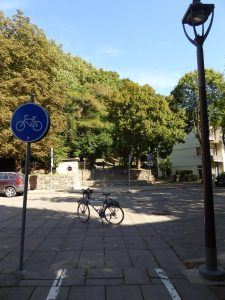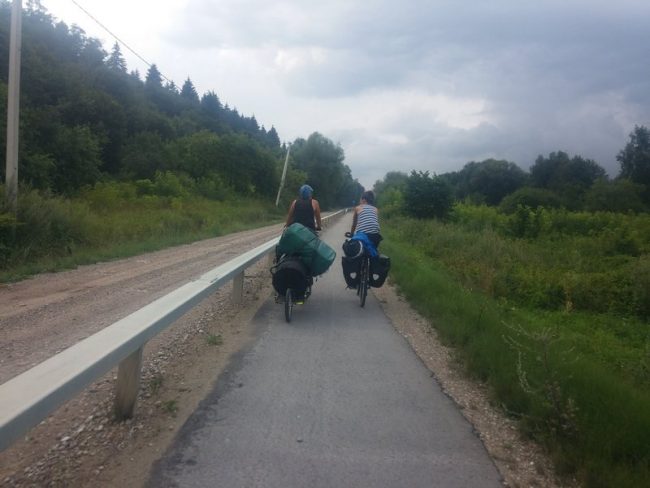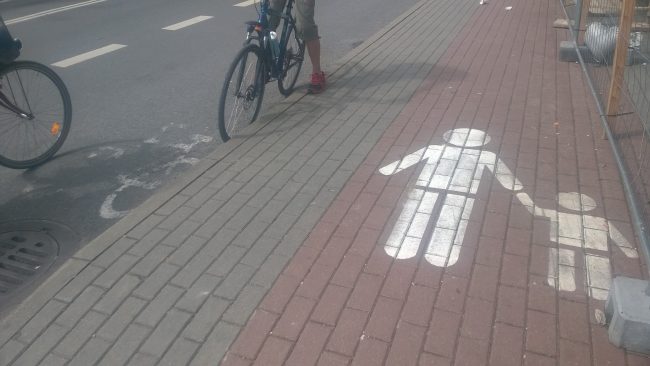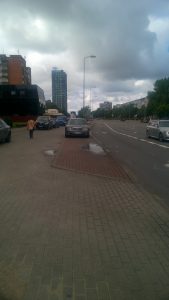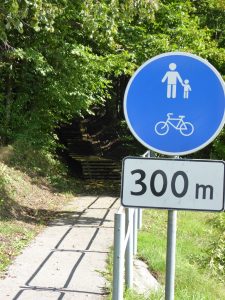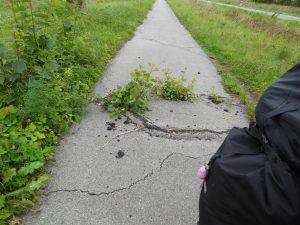We met quite a bunch of nice alternative minded people on the Sapfo-Festival. Most of them didn’t even understand the concept of travelling by bike. How can you carry all the stuff that you need? The festival happened 45km far from Kaunas where many people who joined the festival live. Only two of them arrived by bike.
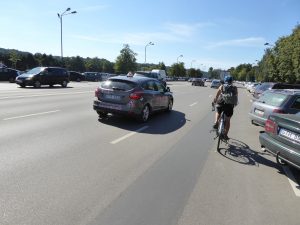 In Kaunas, lets better call it Carmass, cycling was really horrible. Everywhere, there are 4- or 6-lane roads filled up with cars. Sometimes a bike-path goes along but it is normally so bumpy that it’s uncycleable if you are not riding a mountainbike. The smaller roads are either in very bad condition or the are cobblestone streets with narrow sidewalks. Also not cycleable. For crossing the railways in the middle of the town you either have to cycle some kilometers to the next bridge or you carry your bike down and up really gigantic huge stairways.
In Kaunas, lets better call it Carmass, cycling was really horrible. Everywhere, there are 4- or 6-lane roads filled up with cars. Sometimes a bike-path goes along but it is normally so bumpy that it’s uncycleable if you are not riding a mountainbike. The smaller roads are either in very bad condition or the are cobblestone streets with narrow sidewalks. Also not cycleable. For crossing the railways in the middle of the town you either have to cycle some kilometers to the next bridge or you carry your bike down and up really gigantic huge stairways.
But actually Carmass would have a lot of potential to transform itself into Bikemass. In many other cities there is very little space, so cars cyclists and pedestrians have to share it. In Kaunas it would be easily possible to cut off one lane of all these gigantic roads and give it to cyclists. It is proved many times that more roads don’t solve the problem of traffic jams but just increase the number of cars. So less roads would mean less cars and probably more cyclists in the end. A really awesome project would be to have a proper cycleable way to cross the railways. (see the movie Bikes vs. Cars on that topic)
We met a person who was a cycling officer in the local municipality. When we talked to her about these things, she said that there are quite a few cyclists but at another time. And that they do a lot for cyclists such as dinner-events where they give tote bags to all the cyclists. Well, the question is then, how tote bags help to improve the cycling in the city. Also when we cycled together, we discovered some quite weird habits. When we turned left, she stopped at the side of the road, got off her bike, waited until all the cars passed and pushed her bike across the two streets while we were waiting for her. In general, people don’t cycle on the streets there. There is basically no difference between cyclists and pedestrians.
Nevertheless we discovered one nice bike-path while cycling out of the town. Actually it was the first proper bike-path we cycled on at all. The crazy thing about it was that none of the locals knew about it. They all recommended us to cycle on the big road north of the river instead of taking this really nice way.
Klaipeda wasn’t much friendlier for cyclists, or at least the centre was a bit complicated. There were indeed some cycle paths, eg. the whole length of the high street had a red path along the pavement which could be easily confused for a bike path and so it was for maybe 50 m, only to turn into a pedestrian part with symbols of a person with a child substituting a bicycle. The two-colour division seemed confusing for everyone and we saw many cyclists going on the pavement all the way along ringing their bells at pedestrians, even after the pedestrian symbol appeared. What they didn’t realize was from that point cyclists are sent on the road with cars and buses which really don’t know how to behave around cyclists. Especially buses don’t have enough space to take over and so they drive very closely.
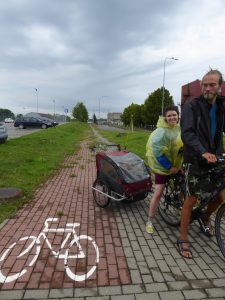 Heading outside of Klaipeda, southwards the system of bike paths seemed a lot more sensible, minus one pictured here which looked more like a car park despite a sign for a bike path. Nearly all of them were paved with bigger or smaller paving stones (uneven surface, never asphalt) and many had high curbs rendering cycling on a touring bike with heavy luggage difficult.
Heading outside of Klaipeda, southwards the system of bike paths seemed a lot more sensible, minus one pictured here which looked more like a car park despite a sign for a bike path. Nearly all of them were paved with bigger or smaller paving stones (uneven surface, never asphalt) and many had high curbs rendering cycling on a touring bike with heavy luggage difficult.
In the countryside, there are generally 2 types of roads: sandy, muddy or bumpy gravel roads or highways, busy with many trucks. Sometimes we where lucky to cycle on nicer smaller asphalt roads that where not so busy, so as from the Belarusian border until the highway that led to Vilnius.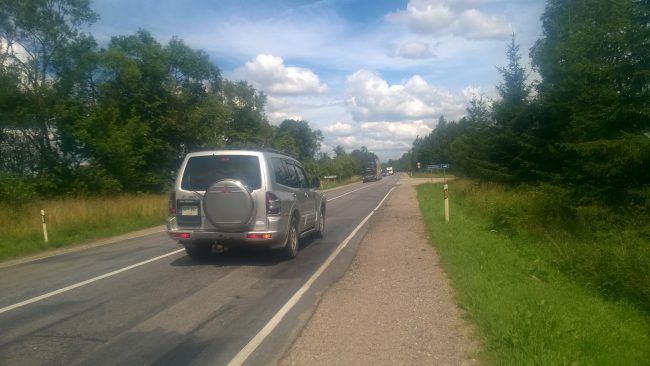
On all our way from Belarus to Latvia we rarely saw any cyclists. In Belarus and Poland, there weren’t so many either but at least in the villages kids and old people were cycling around. Just on the coast there were suddenly loads of them. But the main purpose of cycling there was, to get from your hotel to the beach. It was very tiring, to cycle on that bike-path because people on bikes still behaved as if they were pedestrians. They would just turn without any signs or block the way while having stopped for a chat. There were also quite a few other bike-travelers who struggled with the crowded bikelane. After some kilometers the Eurovelo 10 cycling-path joined the highway(!), so we didn’t have to worry anymore about the crazy tourists. Therefore we had some huge trucks as new friends.
Well, anyways these were our last kilometers in Lithucarnia, now we are cycling in Latvia. Liepaja, the first town we stopped by was already a very nice cycling city!
May be the reason, why no local people join the biketour this year is that they just don’t consider cycling as a nice way to travel. Which is quiet understandable when you see the circumstances. Only the rich german tourists do biketravelling in Lithuania. On the Eurovelo 10 along the coast.
PS: In the end, at least one local person joined us for some days!
PPS: Right after they left the biketour, they bought themself a car…






